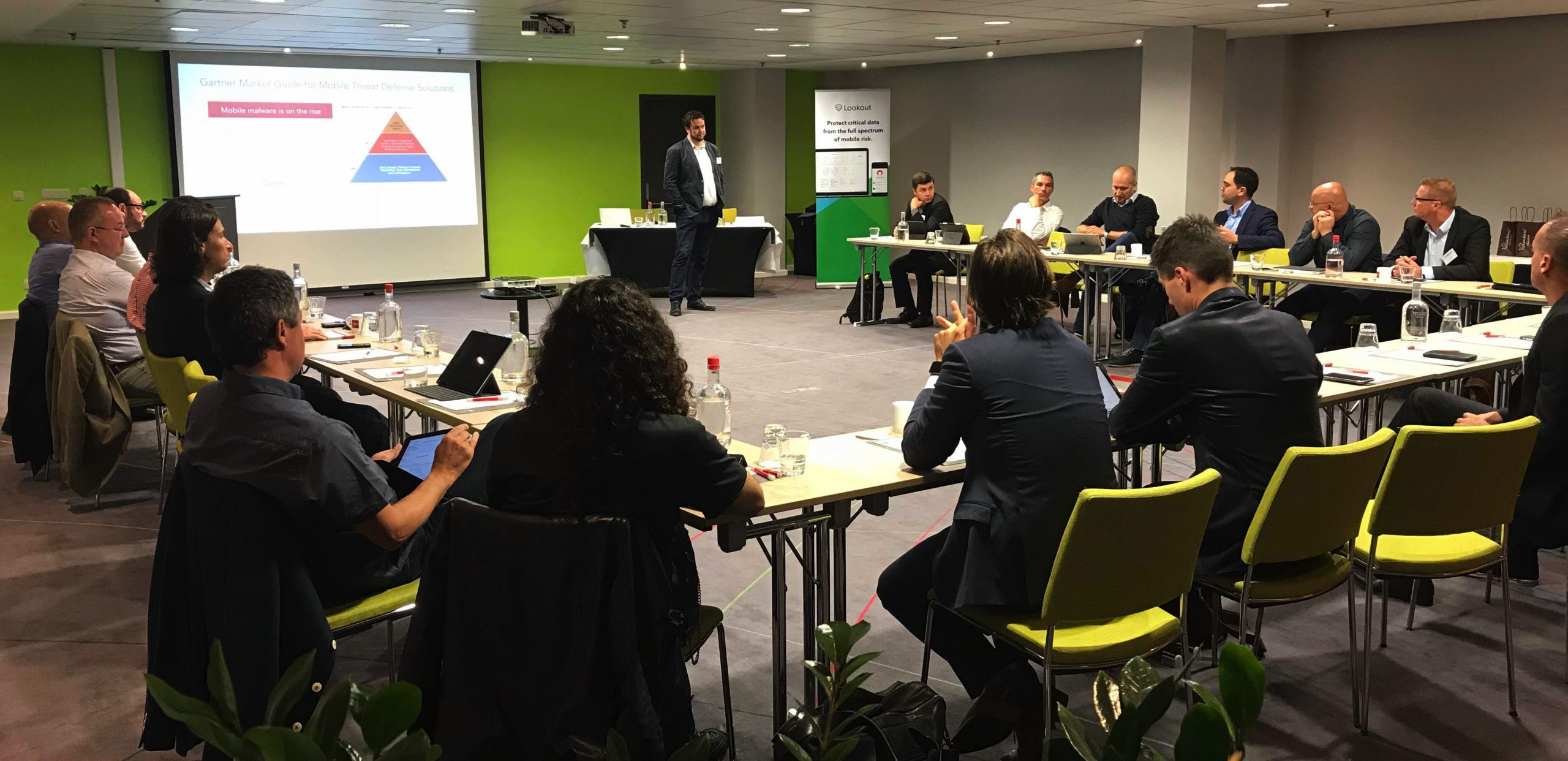This blogpost is written based on the feedback gathered during our Roundtable event on September 27th, based on my notes and interpretation.
Gartner states that the default management platform for employee devices, from PC to smartphone, should be an Enterprise Mobility Management platform (aka MDM). The same firm states that the driver for business transformation is the digital workplace (Digital Workplace Summit London 2017). You can find an article on the conference here.
And since the digital workplace is mobile first, reason enough for us to organize a Roundtable with customers and subject matter experts. On September 27th we welcomed Mike Murray from Lookout and Apple experts to cover 2 important questions on this ongoing business transformation: is it secure and can how can it improve the way I work?

Mike started by describing the new normal: most employees just want connectivity and do not longer want to be linked to a physical location to gain access to work resources. Hence the title of this post and the conclusion that the traditional network perimeter is disappearing.
Traditional protection mechanisms are failing hard today, traditional SPAM filters are doing a great job in preventing people from clicking on malicious links – because they block the message – but what if that message is passed to the user via a different channel, say Facebook or Twitter? Cybercriminals are ready for their next big business and are massively moving towards mobile to gain access to your private data, corporate data, passwords, … Already today we find malware on 47 out of 1000 android devices and 1 out of 1000 on iOS. Downloading from official app stores is strongly recommended, as this seems to be the number one location to get ‘infected’. But users are sometimes not always aware they will get infected, the example Mike gave where a parent gets a text message that his daughter was in a traffic accident and “click here to find out in which hospital she is” illustrates how advanced, persistent and “low“ these criminals act.
Android is clearly the most targeted platform, partly due to the fragmentation of the platform and the inherent lower security, but also because this is the dominant platform in those regions where cyber criminals are mostly active; China and Russia. In that respect we are lucky we can learn from what’s going on and protect ourselves.
To start, a correct configuration of the mobile device taking advantage of all configuration settings in terms of security is mandatory. These first measures are no guarantee, but they will certainly rule out the most common issues in the public/hacking domain.
Moving to the second part of the Roundtable the discussion was more oriented towards business functionality and what new features iOS 11 brings. But before diving into the new toolset that is made available to the entire iOS community, we need to check where we are in the ‘Mobile Journey’. Transforming a business takes time to move from a physical location for work towards a digital workplace that responds to the A3 strategy (the project name chosen by UBS in London for Any time, Any place and Any device – their concrete objective for the digital workplace). Most of the companies represented around the table are today only using a basic set of functionalities on the mobile device, only a limited set of more advanced apps. It is clearly understood the employees want more, but the back-end systems are just not ready – yet.
A question we often get is how to transform a PC application to a mobile app. In our mind we don’t think you should do that. PC application are built in different era when software engineers were asked to put as much features as possible in one application, hence the menu, sub menu and right click options. These applications require training and are offering features of which only 20% are used. Mobile apps are developed with the user experience in mind, require no training and are used for 100% of their features – since ideally there is only one, the app itself.
Many of the attendees are currently not investing in such applications that could redefine their business processes. Not yet. The mobile journey towards the digital workplace is a process that can take many years and where some parts of the business are faster than (more regulated) others. Facebook as an example: banned in the beginning and today absorbing large chunks of the consumer marketing budgets with active daily usage. Aside the commercial interest there is also the employee who wants to use new tools and the risk of shadow IT when no adequate tooling is provided.
As a consensus we also concluded not all functions in a company require a mobile first approach ‘today’. The form factor of their prime computing device for business is defined by their function and personality.
It is up to IT to provide the most rich menu card to these employees in terms of functionality and security. With iOS 11 Apple is adapting the OS, the interface and apps to the business level. The Dock is there when you need it, multiple windows are open to accommodate easy switching between apps, drag&drop allows easy content creation, … the number of new features that in some form or shape feel familiar are now available on the most powerful mobile platform. iOS 11 in combination with the iPad Pro invites you to find new, easy, simple ways to do your job.
During the entire Roundtable we used the new Apple TV to present, wireless.  We know that’s not a new feature, but the magic can be found under the hood. The Apple TV is automatically configured when it’s plugged in for the first time using, imagine what that means for business meeting rooms. No IT interactions needed, from procurement to production.
We know that’s not a new feature, but the magic can be found under the hood. The Apple TV is automatically configured when it’s plugged in for the first time using, imagine what that means for business meeting rooms. No IT interactions needed, from procurement to production.
Let us assist you in your mobile journey and contact us to learn more about our workshop business transformation and the digital workplace!
